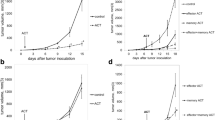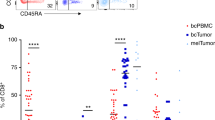Abstract
Background
Immunotherapeutic cancer protocols often rely on the ability to promote proliferative expansion of tumor-specific T-cell, but the influence of cancer on in vivo T-cell expansion remains largely undefined.
Methods
The ability of control and B16F10 melanoma-bearing C57BL/6 mice to expand lymphocytic choriomeningitis virus antigen-specific T-cell populations in response to acute viral infection was compared by using flow cytometric assays of splenocytes.
Results
The ability to expand virus-specific CD8+ and CD4+ T-cells was globally and markedly suppressed in tumor-bearing mice. Expanded cytotoxic T lymphocytes (CTLs) retained in vivo and in vitro functionality, suggesting that melanoma growth did not induce T-cell anergy. The magnitude of suppressed proliferative expansion was proportional to the extent of tumor burden. Melanoma-induced suppression of CTL expansion was correlated with upregulated apoptotic activity and hampered the induction of memory precursor effector cells. Adoptive transfer of resting LCMV antigen-specific T-cells before or after tumor establishment demonstrated that a critical period of in vivo exposure of resting T-cells to growing melanoma was responsible for the induction of suppressed expansion. This suppression was durable; surgical resection of melanoma after in vivo exposure to resting T-cells but before antigenic stimulation did not restore full expansion.
Conclusions
These data suggest that growing melanoma tumors exert a global, antigen-independent influence on resting T-cells that fundamentally reprograms their ability to undergo proliferative expansion in response to subsequent antigenic stimulation. This finding may have direct implications for T-cell-based immunotherapeutic strategies.





Similar content being viewed by others
References
Koebel CM, Vermi W, Swann JB, et al. Adaptive immunity maintains occult cancer in an equilibrium state. Nature. 2007;450:903–7.
Rosenberg SA, Dudley ME. Adoptive cell therapy for the treatment of patients with metastatic melanoma. Curr Opin Immunol. 2009;21:233–40.
Rosenberg SA, Restifo NP, Yang JC, et al. Adoptive cell transfer: a clinical path to effective cancer immunotherapy. Nat Rev Cancer. 2008;8:299–308.
Marincola F, Wang E, Herlyn M, et al. Tumors as elusive targets of T-cell-based active immunotherapy. Trends Immunol. 2003;24:335–42.
Dunn GP, Old LJ, Schreiber RD. The three E’s of cancer immunoediting. Ann Rev Immunol. 2004;22:329–60.
Kim R, Emi M, Tanabe K. Cancer immunoediting from immune surveillance to immune escape. Immunology. 2007;121:1–14.
Lockhart DC, Chan AK, Mak S, et al. Loss of T-cell receptor-CD3ζ and T-cell function in tumor-infiltrating lymphocytes but not in tumor-associated lymphocytes in ovarian carcinoma. Surgery. 2001;129:749–56.
Rabinovich GA, Gabrilovich D, Sotomayor EM. Immunosuppressive strategies that are mediated by tumor cells. Ann Rev Immunol. 2007;25:267–95.
Lizee G, Cantu MA, Hwu P. Less yin, more yang: confronting the barriers to cancer immunotherapy. Clin Cancer Res. 2007;13:5250–5.
Grayson JM, Harrington LE, Lanier JG, et al. Differential sensitivity of naïve and memory CD8+ T cells to apoptosis in vivo. J Immunol. 2002;169:3760–70.
Ahmed R, Salmi A, Butler LD, et al. Selection of genetic variants of lymphocytic choriomeningitis virus in spleens of persistently infected mice: role in suppression of cytotoxic T lymphocyte response and viral persistence. J Exp Med. 1984;160:521–40.
Murali-Krishna K, Altman JD, Suresh M, et al. Counting antigen-specific CD8 T cells: a reevaluation of bystander activation during viral infection. Immunity. 1998;8:177–87.
Hou S, Hyland L, Ryan KW, et al. Virus-specific CD8+ T-cell memory determined by clonal burst size. Nature. 1994;369:652–4.
Oizumi S, Deyev V, Yamazaki K, et al. Surmounting tumor-induced immune suppression by frequent vaccination or immunization in the absence of B cells. J Immunother. 2008;31:394–401.
Schreiber TH, Deyev VV, Rosenblatt JD, et al. Tumor-induced suppression of CTL expansion and subjugation by gp96-Ig vaccination. Cancer Res. 2009;69:2026–33.
Danna EA, Sinha P, Gilbert M, et al. Surgical removal of primary tumor reverses tumor-induced immunosuppression despite the presence of metastatic disease. Cancer Res. 2004;64:2205–11.
Caldwell SA, Ryan MH, McDuffie E, et al. The Fas/Fas ligand pathway is important for optimal tumor regression in a mouse model of CTL adoptive immunotherapy of experimental CMS4 lung metastases. J Immunol. 2003;171:2402–12.
Agrawal S, Marquet J, Delfau-Larue MH, et al. CD3 hyporesponsiveness and in vitro apoptosis are features of T cells from both malignant and nonmalignant secondary lymphoid organs. J Clin Invest. 1998;102:1715–23.
Kaech SM, Tan JT, Wherry EJ, et al. Selective expression of the interleukin 7 receptor identifies effector CD8 T cells that give rise to long-lived memory cells. Nat Immunol. 2003;4:1191–8.
den Boer AT, van Mierlo GJD, Fransen MF, et al. The tumoricidal activity of memory CD8+ T cells is hampered by persistent systemic antigen, but full functional capacity is regained in an antigen-free environment. J Immunol. 2004;172:6074–9.
Acknowledgment
This work was supported by grant support from the Department of Veterans Affairs, Veterans Health Administration, Office of Research and Development, Biomedical Science Research and Development Service, Career Development Award (CDA-2), American College of Surgeons Faculty Research Fellowship, and Central Surgical Association Foundation Grant to CSC.
Conflicts of interest
There are no potential conflicts of interest; the contents of this work do not represent the views of the Department of Veterans Affairs or the United States Government.
Author information
Authors and Affiliations
Corresponding author
Electronic supplementary material
Below is the link to the electronic supplementary material.
Supplementary Fig. 1
Timing of T-cell expansion and contraction is not altered in the presence of cancer. Splenocytes were harvested on day 16, 18, or 20 (corresponding to post-LCMV infection days 6, 8, and 10, respectively) and were analyzed by flow cytometry. Comparison of CTL populations specific for NP396 (a) and GP33 (b) identified a similar pattern of expansion and contraction between tumor-bearing mice (“tumor”) and non-tumor–bearing mice (“control”). Analysis of cellular proliferation as measured by Ki-67 high expression among NP396-specific CTLs (c) and GP33-specific CTLs (d) at the three time points showed no significant differences between tumor-bearing mice (“tumor”) and non-tumor–bearing mice (“control”). Analysis of cellular apoptosis as measured by Annexin Vhigh expression among NP396-specific CTLs (e) and GP33-specific CTLs (f) at the three time points showed more apoptotic activity on postinfection day 8 in tumor-bearing mice (“tumor”) compared with non-tumor–bearing mice (“control”). (g) Smaller populations of MPECs as measured by CD127 high/KLRGlow expression among NP396-specific and GP33-specific CTLs were observed in tumor-bearing mice (“tumor”) compared with non-tumor–bearing mice (“control”) on day 20 (DOC 61 kb)
Rights and permissions
About this article
Cite this article
Russ, A.J., Wentworth, L., Xu, K. et al. Suppression of T-Cell Expansion by Melanoma is Exerted on Resting Cells. Ann Surg Oncol 18, 3848–3857 (2011). https://doi.org/10.1245/s10434-011-1667-6
Received:
Published:
Issue Date:
DOI: https://doi.org/10.1245/s10434-011-1667-6




